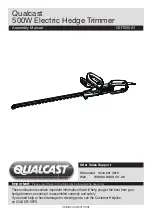
English
21
wrench or a key left attached
to a rotating part of the pow-
er tool may result in personal
injury.
e
Do not overreach. Keep
proper footing and bal-
ance at all times.
This ena-
bles better control of the
power tool in unexpected sit-
uations.
f
Wear suitable clothing. Do
not wear loose-fitting
clothing or dangling jewel-
lery. Keep your hair, cloth-
ing and gloves away from
moving parts.
Loose
clothes, gloves, jewellery or
long hair can be caught in
moving parts.
g
If devices are provided for
the connection of dust ex-
traction and collection fa-
cilities, ensure these are
connected and properly
used.
Using a dust extrac-
tion system can reduce dust-
related hazards
.
4
Power tool use and care
a
Do not overload the de-
vice. Use the correct pow-
er tool for your
application.
The correct
power tool will do the job
better and safer at the rate
for which it was designed.
b
Do not use the power tool
if the switch does not turn
it on and off.
Any power tool
that cannot be controlled
with the switch is dangerous
and must be repaired.
c
Disconnect the plug from
the power source and/or
the battery pack before
making any adjustments,
changing accessories, or
storing the device.
Such
preventive safety measures
reduce the risk of starting
the power tool accidentally.
d
Store unused power tools
out of the reach of chil-
dren. Do not allow per-
sons unfamiliar with the
device or these instruc-
tions to operate the de-
vice.
Power tools are
dangerous in the hands of
untrained users.
e
Maintain power tools.
Check for misalignment or
binding of moving parts,
breakage of parts and any
other condition that may
affect the power tool’s op-
eration. If damaged, have
the power tool repaired
before use.
Many accidents
are caused by poorly main-
tained power tools.
f
Keep cutting tools sharp
and clean.
Properly main-
tained cutting tools with
sharp cutting edges are less
likely to bind and are easier
to control.
g
Use the power tool, acces-
sories and tool bits etc. in
















































